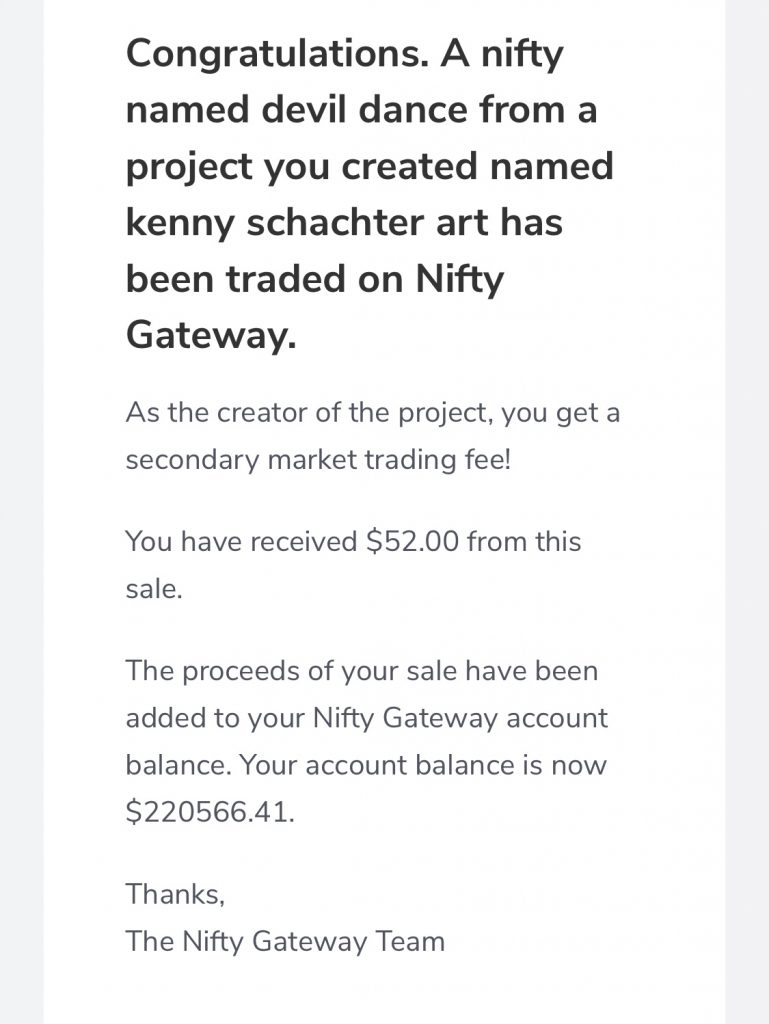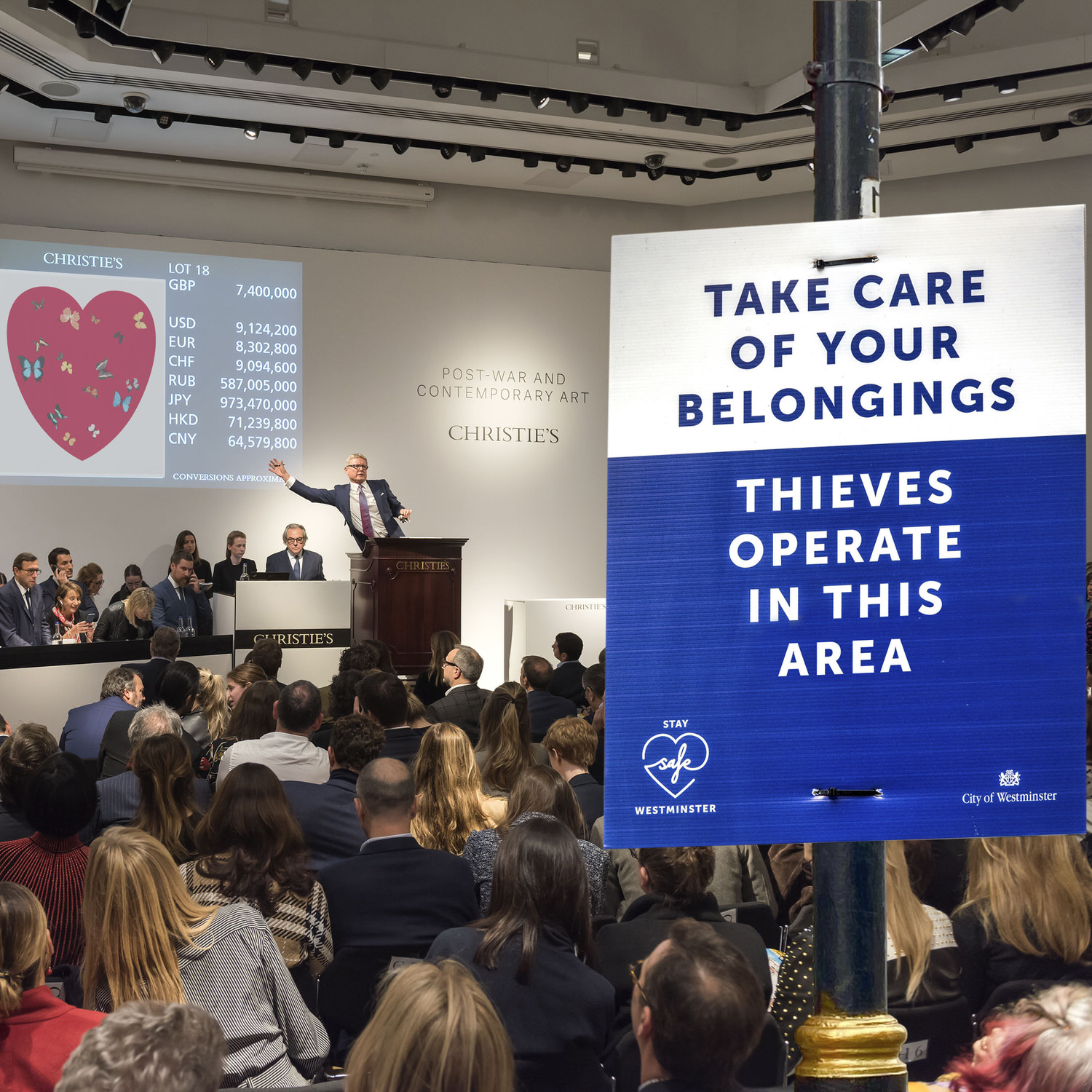My second drop on Nifty Gateway—woohoo, I reinvented myself in late middle age. Courtesy of Kenny Schachter.
While writing this, I’m on WhatsApp chatting to a friend, listening to (yet another) Clubhouse talk drone on, and participating in a group discussion on Discord. If you have to ask what any of those are, you may not want to read any further. The topic du jour? A new pandemic that’s spreading quicker than COVID, and though it won’t be as devastating health-wise (and I’ve been fighting chronic headaches and fatigue months after fending off the virus), it may cause a lot of pain—financially, that is. Put simply, Non Fungible Tokens (NFTs) are digital artworks hosted on a decentralized peer-to-peer network. In other words, it’s a way of layering imagery onto the cryptocurrency blockchain—and there’s more breaking news in this sector of collecting right now than there was in any given week of the Trump administration. People are talking about it A LOT.
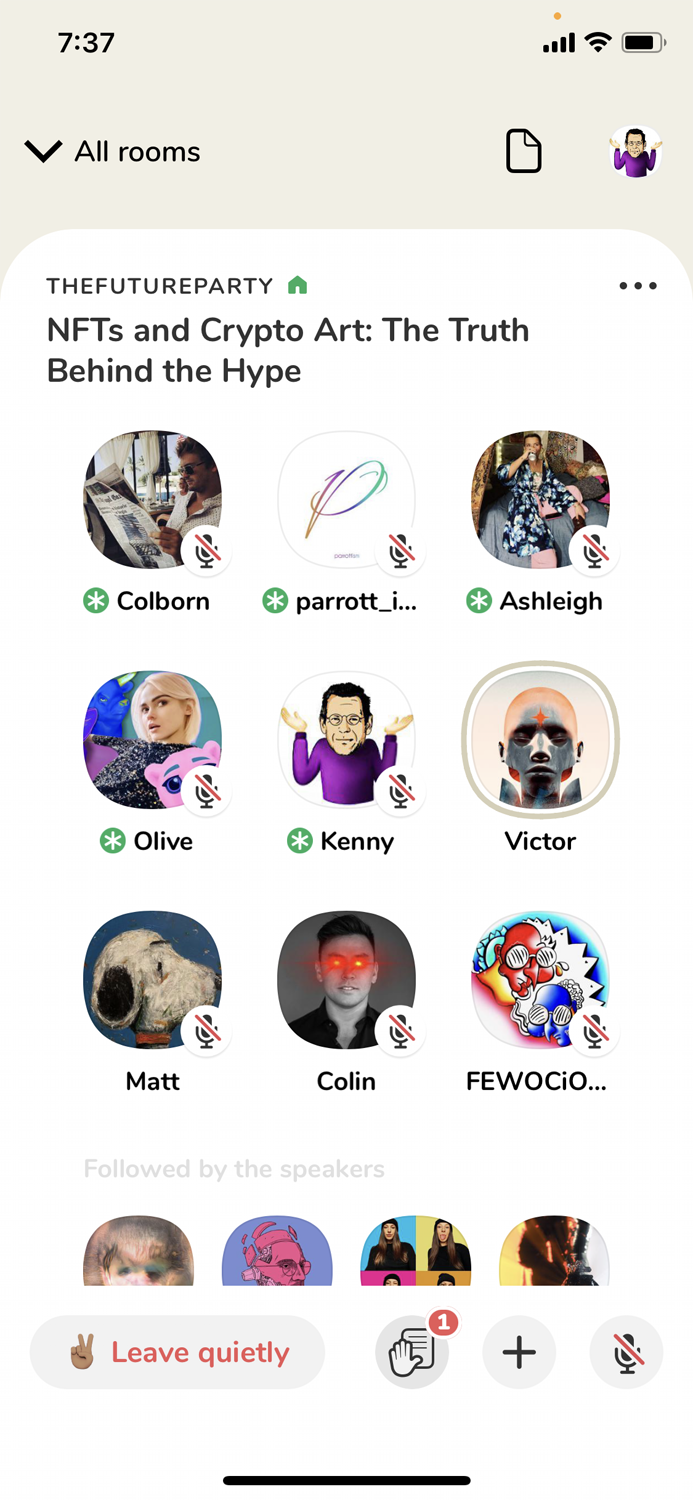
I think Clubhouse was invented to rake over NFT. Thanks to artist Olive Allen for introducing the app to me way, way back in September 2020! Courtesy of Kenny Schachter.
CryptoPunk collectibles and a work by former baseball-player-turned-artist Micah Johnson have all sold for $2 million over the past few days; Mad Dog Jones launched a $4 million release of his own on Nifty Gateway last week; and Mike Winkelmann, aka Beeple, is set to auction an NFT in early March at Christie’s that has some expecting $50 million. Sorry about all the money talk, but it’s catnip for the flipperati: with NFTs, you have the art part largely stripped from the equation—which is perfect, since they don’t understand it, and it just gets in the way anyhow. At present, most of these things look like screensavers or video-game stills and equate to (crypto) money chasing more (crypto) money. But I get ahead of myself.
Surely you won’t believe me when I recount the nascent rise of NFTs. Some would argue it all began in 2005 with Pepe the Frog, the “sad frog meme” created by Matt Furie that became a symbol for an imaginary currency in a pretend Reddit market to buy and sell memes. A 2017 computer game called Spells of Genesis by EverdreamSoft later utilized “FDCARDS” to be bought and sold as digital assets among players. Communities of traders sprouted around these early-stage digital tokens, and the first to take hold was Counterparty, a crypto platform that used the Bitcoin blockchain to store its data.
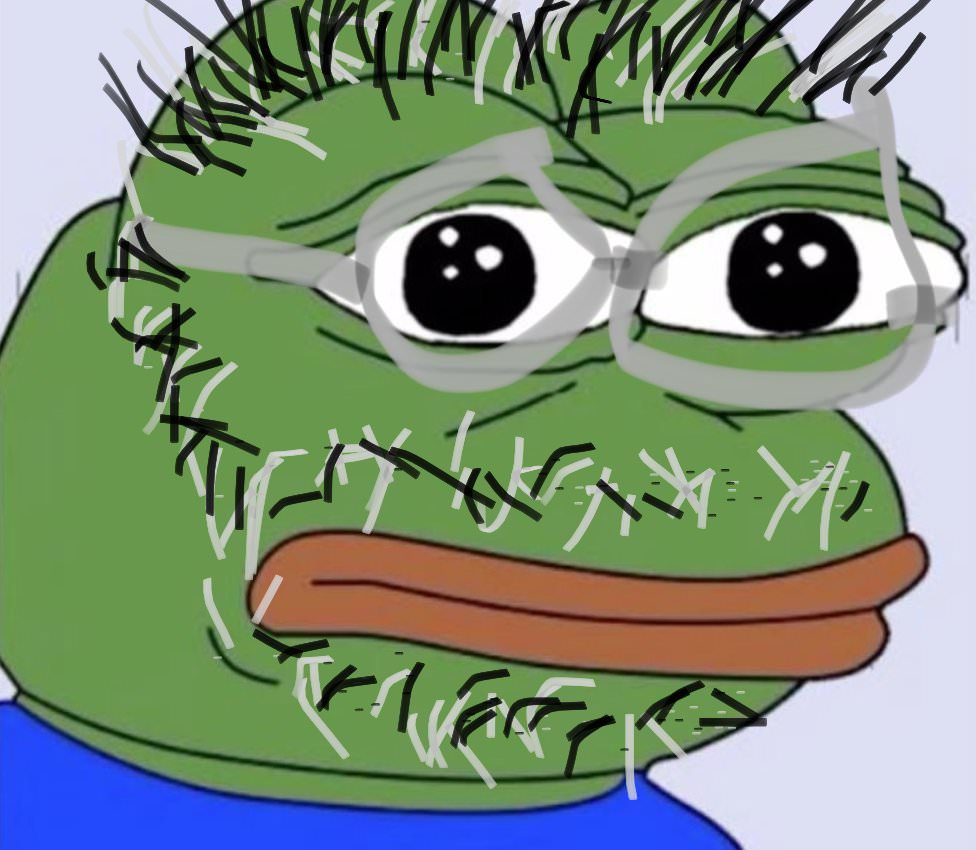
Kenny the sad frog. The Pepe frog meme started the sensation—hope I don’t end it! Courtesy of Kenny Schachter.
NFT digital art arose from these early initiatives, namely Rare Pepe cards by “Mike,” a member of Counterparty who issued online trading cards with, significantly, no game attached. That was the benign-enough breakthrough that brought us, more or less, to where we are now. Rob Meyers tokenized his soul in a 2014 work fittingly enough entitled MYSOUL—and now everyone seems to be doing the same, from the singer Grimes to the painter Canyon Castator. (You can find more in-depth analysis of the early blockchain art historical timeline here and here.)
Personally, I’ve been making digital art since the mid-1990s comprised of large-scale computer prints—which I exhibited with Wade Guyton before he had a printer, and available for a fraction of the cost—and, other than traditional photographic prints or, in later years, memory sticks for videos, there has never been an easily digestible commercial delivery system to introduce these works into the stream of commerce. Nor much of a market, either—for artists like me, anyway. Conceptual video art pioneer Vito Acconci died in 2017 all but destitute. Nam June Paik is probably the most expensive video artist in the field, with a record set in 2019 at $1.3 million; Mike Kelley made $1.1 million for a video installation in 2007, meanwhile, and Bill Viola fetched $700,000 back in 2006.
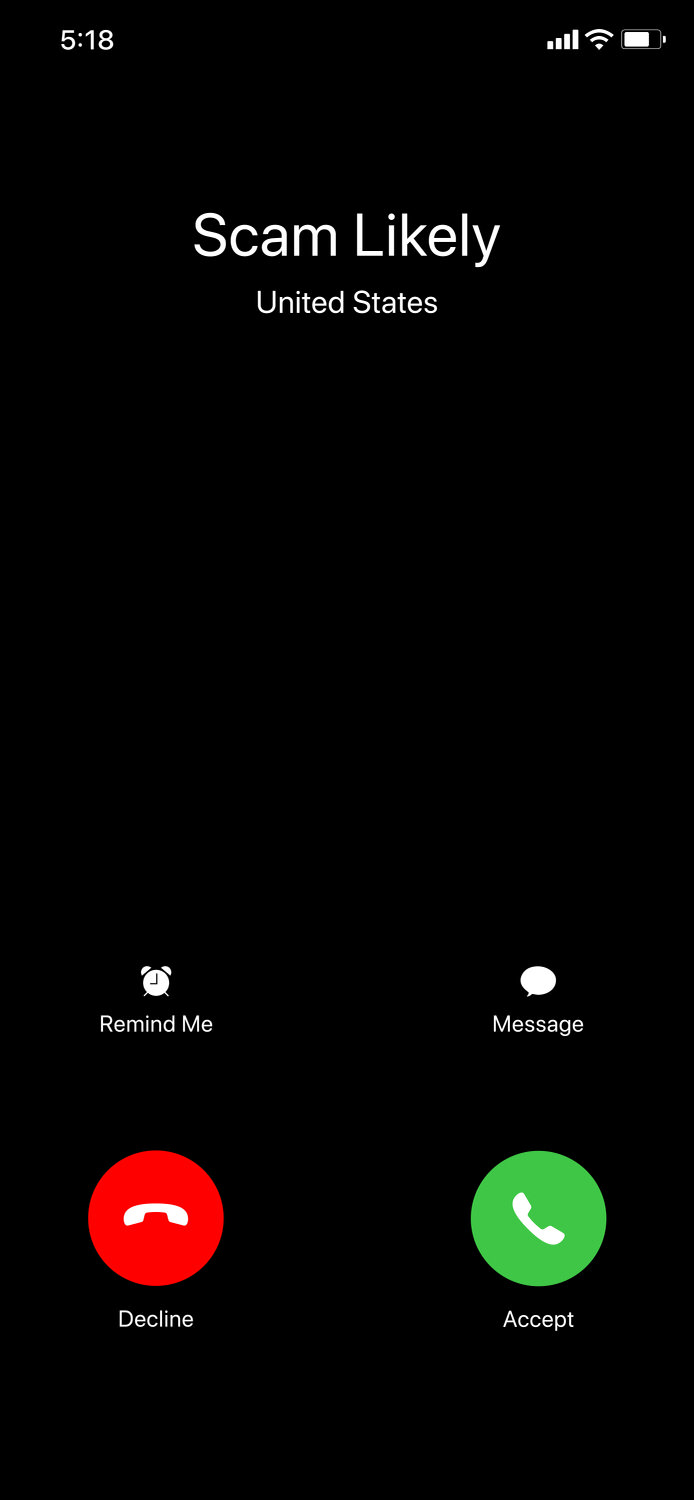
There are a lot of scams in the art world, but this is a revolution! I promise, I’ve been making digital art for 30 years and now there’s finally a marketplace to sell it! Courtesy of Kenny Schachter.
I must admit I’m a bit of a conservative art prude when it comes to collecting, typically shying away from works that that need to be turned on (and off). But, then again, I’m old. Clare McAndrew recently stated that among the world’s top 3,000 art collectors—half of whom reside in New York—only 20 percent purchased art online, even though 90 percent visited gallery websites. When I queried her as to the average ages of poll participants, she conceded they were largely in my aged demographic, too.
Don’t get me wrong—I can readily see the advantages of keeping your collection in your (crypto) wallet instead of tucked away in a freeport or on the wall, for that matter: no shipping, framing, conservation issues, insurance, storage fees, or transaction costs. There is also guaranteed provenance and authenticity, and it can be viewed by anybody, anywhere, while the ownership remains undisputed. What an intriguing universe: so far ahead tech-wise; so far behind in terms of visual content.
Another benefit of NFT art for today’s short-attention-spanned spec-u-lectors? You can flip this shit instantaneously, as in seconds after purchase, and you certainly won’t get any push-back from the artists, since they have resale rights—pegged at 10 percent on average—built right into the smart contracts layered onto the Ethereum currency these works typically trade in. Bitcoin has the potential to do away with the centralized banking system, generally speaking, and NFTs are a potential body blow to the traditional gallery setup, which is already under tech attack as direct buying on Instagram looks set to surpass brick-and-mortar purchases. For the young’uns, anyway—they don’t need any convincing that this is the wave of the future, nor do the crypto investors who had made untold billions in bitcoin (in the last 45 minutes).
One problem, of course, is that a lot of NFT “art” doesn’t communicate much, nor have anything in the way of purpose other than its exchange value. For many in this sector, that’s more than enough. But the gameless video-game aesthetic feels like a mirror of society in the real world today, whatever that may be—and I have no idea anymore. In fact, if you have the right goggles, you can exit the real world altogether to visit self-sufficient meta-hubs like Decentraland, Cryptovoxels, or Somnium Space virtually, where you can buy and sell land, build buildings, and spend the rest of your life in a way that will cost you real money but exist only online. (Then again, clocking in more than 12 hours of screen time a day on my phone, I already do.)
The top platforms to trade NFTs—and most trade them before they even open the files, kind of like… oh, I better not mention his name—are www.superrare.co and www.knownorigin.io, which one digital artist likened to Sotheby’s and Christie’s, inasmuch as they are curated by gatekeepers. On the lower end of the spectrum there’s https://rarible.com, which I guess would make them more akin to Phillips. (Ha, c’mon don’t lose your senses of humor.) That last one is so cheesy, in fact, that they’re already dipping into the bottom of the celebrity C-list barrel by an NFT by Lindsay Lohan—that promptly made nearly $60,000.
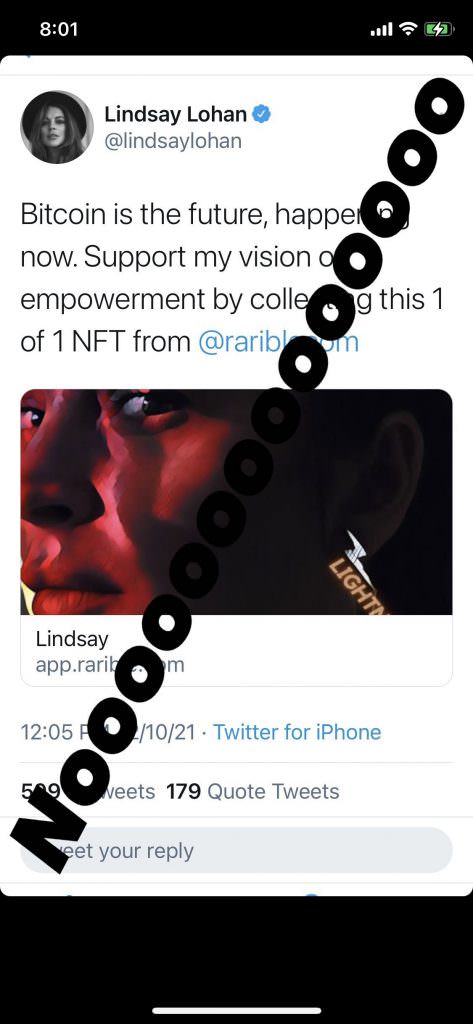
Oh lord, not her too! Lindsay gets into the action and nets nearly $60,000. There’s no accounting for taste, or the lack of it. Courtesy of Kenny Schachter.
I myself released works in December and again on Monday on www.niftygateway.com, the platform started by twins Duncan and Griffin Cock Foster, who sold their company to Cameron and Tyler Winklevoss of Facebook fame. I swear, I’m not funny or imaginative enough to make this up! You can even sell your Tweets on https://v.cent.co—Jerry, did you hear that? By the way, “gas” is crypto lingo for the associative computing costs of minting and transacting in NFTs, which consumes more energy than flying to an art fair. Literally.

Larva Labs’ CryptoPunks: love them or hate them, they are among the first NFT artworks, and I’m learning to appreciate them, albeit slowly. This is actually worth potentially millions (for a while, at least)! Courtesy of Kenny Schachter.
Matt Hall and John Watkinson identify as “Creative Technologists” (née app writers), and they are the Canadian computer scientists, software developers, and, of late, “artists” who founded Larva Labs in 2005 to pursue technology projects. They were early app and game developers for smartphones that pre-dated iPhone and Android; over the past few years, their attention shifted to blockchain, pixel graphics, and mechanisms for creating imagery based on programming parameters, as in AI systems. For instance, they minted 10,000 unique characters with proof of ownership stored on the Ethereum blockchain that have now traded for upwards of $2 million apiece. Another project along the same lines involves Autoglyphs, the first “on-chain” generative art on the Ethereum blockchain. The problem (for me, anyway, not investors) is that that they look like digital crap. But kudos for being on the ground floor and pretty much pioneering NFT-dom, so in that sense alone I don’t dismiss them (entirely).
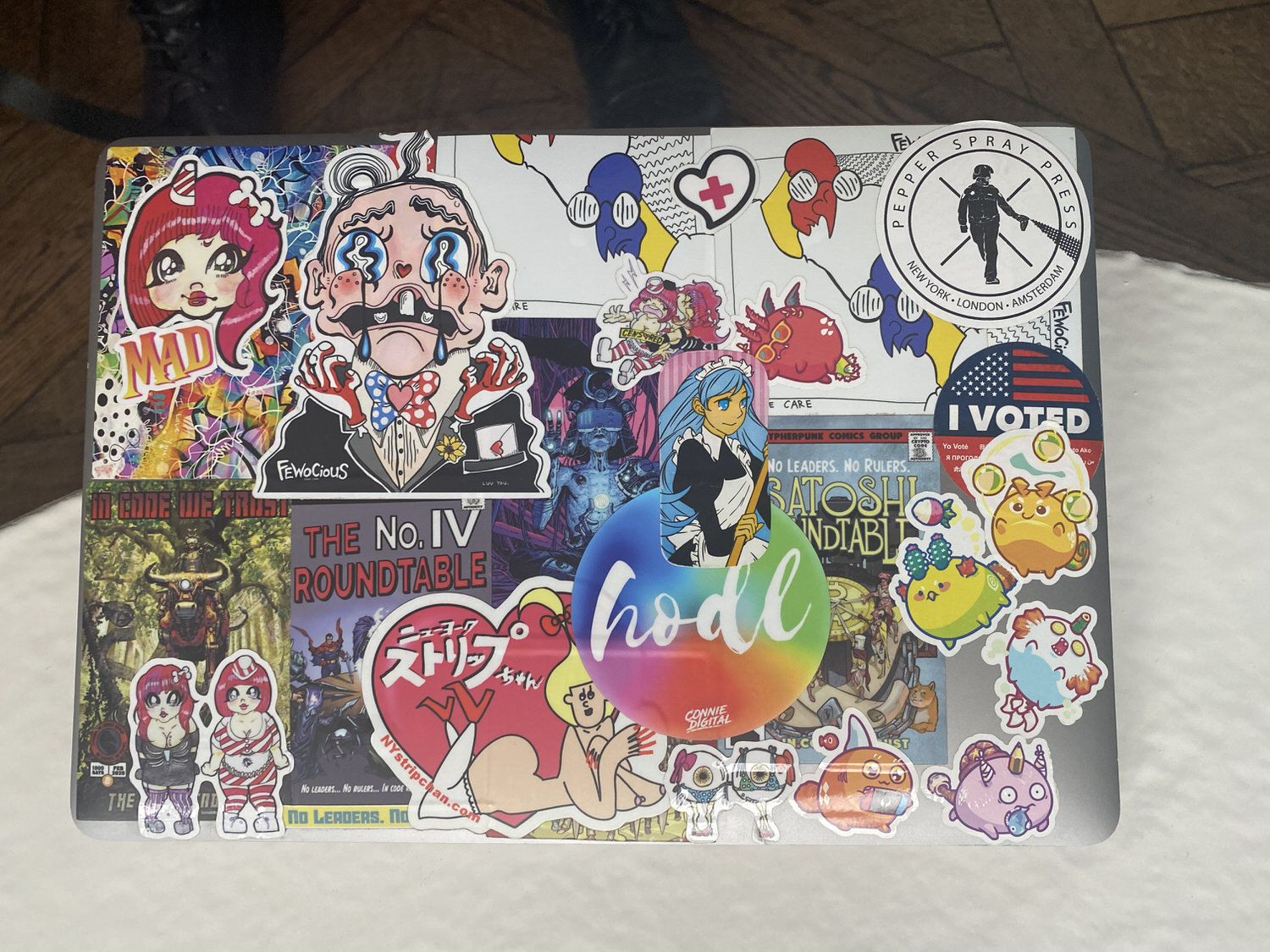
Colborn’s computer! Owner of first NFT museum, fittingly enough called MOCA of course (Museum of Crypto Art). Courtesy of Kenny Schachter.
Now there is even a crypto museum with the catchy name: the Museum of Crypto Art (MOCA—another one!), founded by investors Pablo Rodriguez-Fraile and Colborn Bell, although they have since split their partnership and drawn a literal line in the digital sand, separating their assets in Somnium. I met with Colborn, who is a passionate, well-informed digital native who taught me a lot and sparked my enthusiasm to learn more. The problem is that these folks need to open a few history books and learn about art-art if they really want to make a lasting historical impact. What I particularly respond to is the us vs. them mentality of trying to provoke change by taking matters into their own hands and unsettling the status quo.

Robness and his “64 GALLON TOTER,” the beginning of TRASH art NFTs, lifted from a Home Depot catalogue. Yours for $53 million! Really. Courtesy of Kenny Schachter.
Accessibility, even in the land of NFTs, is still tightly controlled, and copyright issues crop up à la Richard Prince (of Thieves). In fact, one artist, Robness, got thrown off a platform for nicking a Home Depot garbage bin and digitizing it! So much for the spirit of rebellion. The artist known as Pest Supply has made Banksy-esque works that sell for $1 million in a day or two—and it turns out that the real author is an art-dealing meme-er on Instagram, but I’m not saying who. The fake Banksys were denied access to OpenSea for perceived copyright infringement, but accepted on another platform. It’s all getting confusing and more than a little silly.

NFT minter Pet Supply’s fake Banksy goes large, and the creator is one of us! But I’m not telling who! Courtesy of Kenny Schachter.
Robness started a whole TRASH art movement with Max Osiris, xcopy, coldie, and others—I like that they incorporate glitches, i.e. technical mistakes, into their processes. (It’s something I can relate to—I make enough of them in real life.) Colborn, who even has a digital-sounding name, characterized this “movement” as “a commentary on our ridiculously litigious, hyper-commercialized society which protects the IP of an image of a trashcan over a person’s (artist) desire to express themselves. It’s a fuck you to anyone that’s ever told you that you’re not good enough, that you can’t do something.” That would apply to my parents and teachers, though at times I fear they may have been on to something.
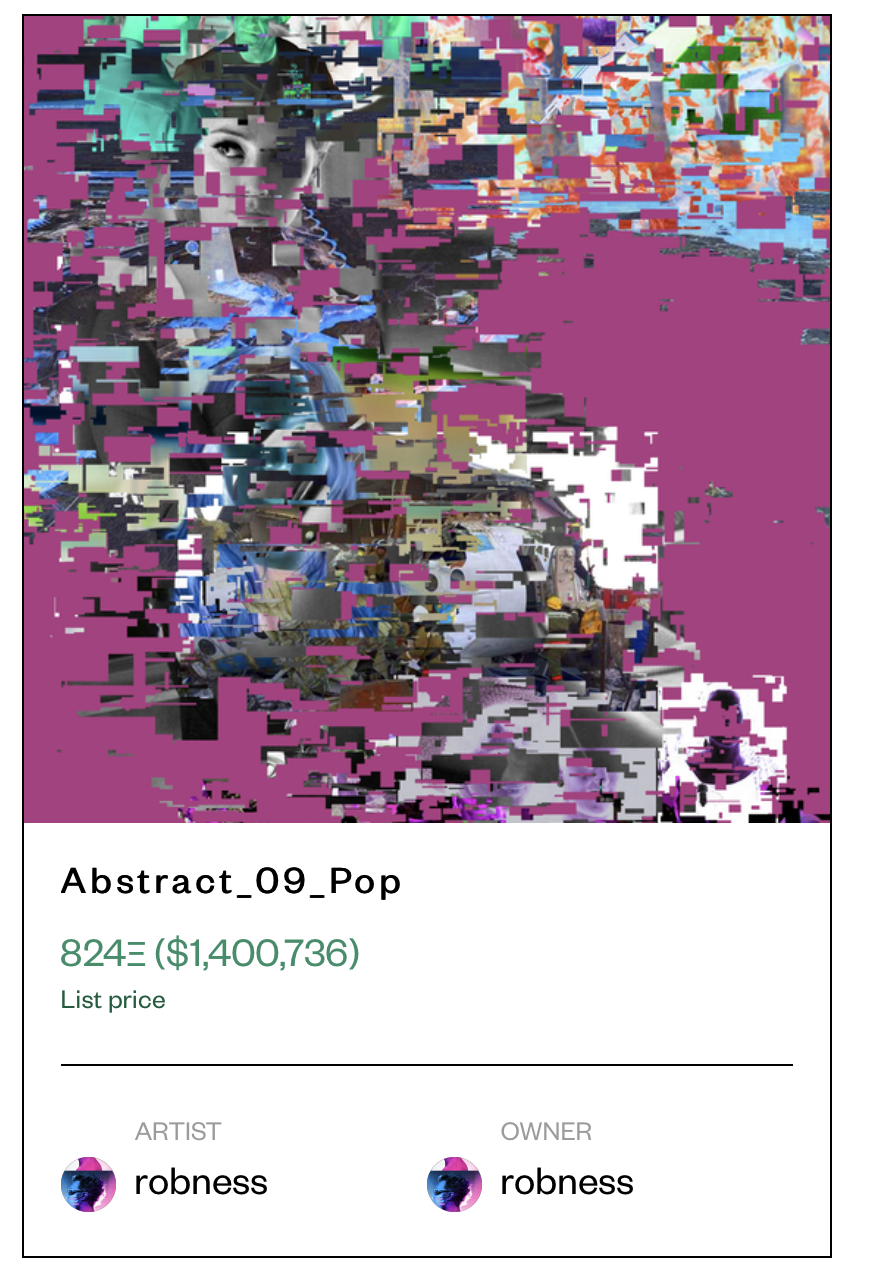
His Robness: this shit is for real. Courtesy of Kenny Schachter.
The artist Pak made an NFT of a single, teeny-tiny, nearly microscopic red pixel that is kind of like the Malevich of NFTs, and the 29-year-old Nigerian artist Osinachi—another one I like, and who has been at it since 2017—renders portraits that are super engaging and reminiscent of Amoako Boafo but beyond, with compositional complexity and the application of animation. There are even some emerging digital dealers, like Kate Vass in Switzerland, a longtime proponent of another early pioneer in the field, Irish conceptualist Kevin Abosch, who at 51 is closer to Gen A (me) than Gen Z (6-to-24-year-olds). Also, I met another resident of Switzerland—which has its own thriving crypto Silicon Valley—named Georg Bak who defines himself as a “Digital Art Advisor.” If I wasn’t such a fervent practitioner and believer, I would say this already smells like the end! But, I’m afraid, there’s no turning back, as much as you’d like to stuff the Ethereum back into the ether.

An Osinachi self-portrait paying tribute to his Igbo heritage. Courtesy of Kenny Schachter.
This is a market that moves so fast you can barely fact-check it. (How’s that for a disclaimer?) Inevitably, NFTs will be used as collateral for loans and can possibly kick off interest of some stripe. There are DAOs (Decentralized Autonomous Organizations) where investors pool funds on the blockchain to jointly invest that sound like a challenge to the traditional model of companies issuing shares. I know of one, called Flamingo, that invests in NFTs and paid nearly $700,000 for a CryptoPunk, the value of which has skyrocketed. For the time being, anyway. There are even bluechip NFT art sites raising money as I type, but they entirely miss the point and won’t attract the right crowd: kids and the nouveau crypto riche. I predict there will be monster crimes and misdemeanors in a heartbeat—there always are when large sums of cash (even the crypto variety) are involved. How long before there’s an NFT Inigo? Right now the dichotomy between “gallery” or “real” art vs. NFTs seems like an insurmountably wide gulf, but they are getting closer as I type. Hang onto your seat and wallet password (or you’re fucked, for real).
UPDATE: I never thought I’d see the day where I’d do a podcast with an 18-year-old recently minted (literally) millionaire crypto artist by the name of Fewocious, but then again nor did I think I’d live to be part of an online digital art drop on Nifty Gateway that crashed the system and netted me a few hundred grand this past Monday night after writing this column (and after slogging along in the art world for more than 30 years). Amen.
